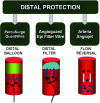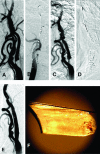Therapeutic advances in interventional neurology
- PMID: 15897952
- PMCID: PMC1064993
- DOI: 10.1602/neurorx.2.2.304
Therapeutic advances in interventional neurology
Abstract
Rapid advances in the field of interventional neurology and the development of minimally invasive techniques have resulted in a great expansion of potential therapeutic applications. We discuss therapeutic interventional neurology as applied in clinical practice in one of the two possible ways: 1) embolization leading to occlusion of blood vessels; and 2) revascularization leading to reopening of blood vessels. These procedures can be applied to a broad range of cerebrovascular diseases. In the first section of this review, we will explore the evolution of these interventions to occlude aneurysms, arteriovenous malformations, neurovascular tumors, and injuries. In the second section, revascularization in acute ischemic stroke, stenosis, and dural venous thrombosis will be discussed.
Figures










Similar articles
-
Indications for the Performance of Intracranial Endovascular Neurointerventional Procedures: A Scientific Statement From the American Heart Association.Circulation. 2018 May 22;137(21):e661-e689. doi: 10.1161/CIR.0000000000000567. Epub 2018 Apr 19. Circulation. 2018. PMID: 29674324 Review.
-
Interventional Neuroradiology: A Review.Can J Neurol Sci. 2021 Mar;48(2):172-188. doi: 10.1017/cjn.2020.153. Epub 2020 Jul 16. Can J Neurol Sci. 2021. PMID: 32669144 Review.
-
Interventional neurovascular techniques for cerebral revascularization in the treatment of stroke.AJR Am J Roentgenol. 1994 Oct;163(4):793-800. doi: 10.2214/ajr.163.4.8092013. AJR Am J Roentgenol. 1994. PMID: 8092013 Review.
-
[Use of different endovascular treatments for arteriovenous malformations of the spinal cord].Zh Vopr Neirokhir Im N N Burdenko. 2002 Jul-Sep;(3):29-37. Zh Vopr Neirokhir Im N N Burdenko. 2002. PMID: 12731361 Russian.
-
Dural arteriovenous fistulas.Klin Neuroradiol. 2009 Mar;19(1):91-100. doi: 10.1007/s00062-009-8038-8. Epub 2009 May 15. Klin Neuroradiol. 2009. PMID: 19636682 Review.
Cited by
-
The interventionalism of medicine: interventional radiology, cardiology, and neuroradiology.Int Arch Med. 2009 Sep 9;2(1):27. doi: 10.1186/1755-7682-2-27. Int Arch Med. 2009. PMID: 19740425 Free PMC article.
-
Characteristics of highly cited articles in cerebral angiography.Neuroradiol J. 2025 Feb 26:19714009251324292. doi: 10.1177/19714009251324292. Online ahead of print. Neuroradiol J. 2025. PMID: 40009826 Free PMC article. Review.
References
-
- Plan and operation of the Third National Health and Nutrition Examination Survey, 1988–94. Series 1—Programs and Collection Procedures. Vital Health Stat 1, 32: 1–407, 1994. - PubMed
-
- Detailed diagnosis and procedures, national hospital discharge survey, 1990. Hyattsville, MD: U.S. Department of Health and Human Services. DHHS publication, Series 13, 1992. - PubMed
-
- Rinkel GJ, Djibuti M, Algra A, van Gijn J Prevalence and risk of rupture of intracranial aneurysms: a systematic review. Stroke 29: 251–256, 1998. - PubMed
-
- Werner SC BA, King BG. Aneurysm of the internal carotid artery within the skull: wiring and electrothermic coagulation. JAMA 116: 578, 1941.
-
- Hopkins LN, Lanzino G, Guterman LR. Treating complex nervous system vascular disorders through a “needle stick”: origins, evolution, and future of neuroendovascular therapy. Neurosurgery 48: 463–475, 2001. - PubMed
Publication types
MeSH terms
LinkOut - more resources
Full Text Sources
Medical

